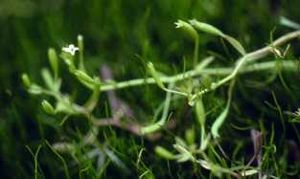Legenere facts for kids
Quick facts for kids Legenere limosa |
|
|---|---|
 |
|
| Scientific classification | |
| Kingdom: | |
| (unranked): | |
| (unranked): | |
| (unranked): | |
| Order: | |
| Family: | |
| Genus: |
Legenere
McVaugh
|
| Species: |
L. limosa
|
| Binomial name | |
| Legenere limosa (Greene) McVaugh
|
|
Legenere limosa is a special wildflower that grows every year. It is part of the bellflower family. This plant is found only in certain areas of Northern California. It is the only plant in its group, which is called the Legenere genus. People often call this flower the false Venus's looking glass or Greene's legenere.
Contents
Where Legenere limosa Grows
This unique flower blooms in May and June. You can find it in wet places, especially in areas called vernal pools. These are temporary pools of water that form in spring and dry up later. The plant grows in places that are lower than 610 meters (about 2,000 feet) above sea level.
Most of these plants grow in specific counties in California. These include Solano County, Sacramento County, Lake County, Napa County, Sonoma County, Tehama County, and Yuba County.
Sadly, Legenere limosa is a very rare plant. The California Native Plant Society says it is "Seriously endangered." This means it is at high risk of disappearing forever.
There are a few main reasons why this plant is in danger. One reason is grazing by animals, which eat the plants. Another problem is invasive species, which are plants or animals that are not native to the area and can harm the local ecosystem. Finally, development (when land is used for buildings or roads) also destroys the places where this flower grows.
What Legenere limosa Looks Like
The stems of the Legenere limosa plant usually lie down on the ground. They can be about 10 to 30 centimeters (4 to 12 inches) long. Even though the main stems recline, the smaller branches that grow off to the sides are strong and stand up straight.
How Legenere limosa Got Its Name
The name of the plant's group, Legenere, is a bit of a puzzle! It's an anagram of "E. L. Greene." This refers to Edward Lee Greene, a scientist who first described this plant in 1890. An anagram means the letters of a word are rearranged to form another word.
The second part of the name, limosa, comes from a Latin word. Limosa means "muddy." This name makes sense because the plant loves to grow in wet, muddy places like vernal pools.
See also
 In Spanish: Legenere para niños
In Spanish: Legenere para niños

